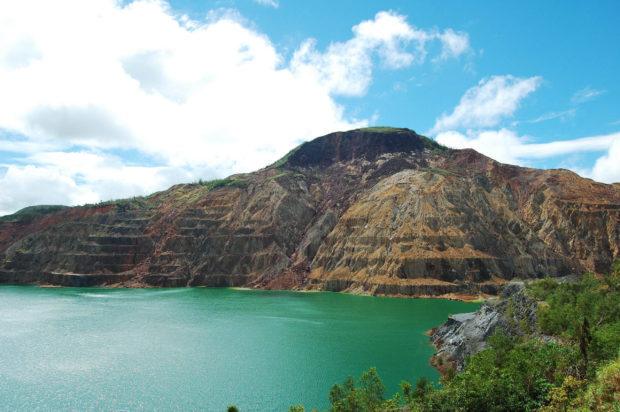
MINED OUT This photo taken in 2010 shows Mt. Tapian and Marcopper Mining Corp.’s open pit in Marinduque province. Access to the old Marcopper mine site has been restricted after it was abandoned following the mine tailings disaster in 1996. —INQUIRER PHOTO
A government team discovered about 100 barrels containing what it described as “radioactive substances” in an old storage facility of the Marcopper Mining Corp. while inspecting the integrity of dams and abandoned structures in the former mining site in Marinduque province.
The Mines and Geosciences Bureau (MGB) disclosed its discovery to a provincial board committee hearing this week that tackled the state of Marcopper’s facility, after Marinduqe was hit hard by Typhoon “Quinta” (international name: Molave) in late October.
Marcopper has been closed since the mine disaster in March 1996, when a leak in one of its mine tailings tunnels spilled more than 1.6 million cubic meters of toxic waste into the Boac River and flooded surrounding villages.
In a telephone interview on Wednesday, Roland de Jesus, the MGB regional director in Mimaropa (Mindoro, Marinduque, Romblon and Palawan), said the agency’s inspection teams found the substance during their “first and second quarter” monitoring this year.
De Jesus said they notified, through a letter on Oct. 27, the local holding company of Marcopper “for immediate [and] proper disposal of the toxic substances.”
The MGB also furnished Philippine Nuclear Research Institute (PNRI) director, Carlo Arcilla, a copy of the letter, calling the agency’s attention to their discovery, he said.
‘Possibly leaked’
The PNRI, a government agency handling nuclear energy research and development, on Wednesday said it was looking into the matter although it had yet to issue an official statement.
De Jesus said the MGB teams “stumbled upon” about 100 blue plastic barrels, with each holding 55 gallons, labeled with “Cesium 137” and “Radium 226” near the company’s Balogo seaport in Sta. Cruz town.
De Jesus said the barrels were “sealed” yet the MGB team was certain these were not empty, as it had also “possibly leaked because of the foul smell in the place.”
Marcopper was a licensed facility, but its PNRI-issued license to possess these substances had already expired on June 30, 2013, according to the MGB.
De Jesus said the storage facility used to be off-limits until recently when government inspectors were allowed access through the private seaport.
While Marcopper had ceased operation after the 1996 mine tailings spill, its facilities remained private property, preventing government inspection.
Among known industry uses of Cesium 137 is to detect liquid flow in pipes (in the case of mining, the flow of tailings) while Radium 226 is added to jewelry for luster, De Jesus said.
“[But] I think it’s not [anymore] common nowadays in copper mines, especially [with the] strict regulation in the possession and handling of radioactive substances. It’s also the first time I’ve heard of a [mining] company using the said substances,” he said.
The discovery of the radioactive substances could add to the string of class suits and claims for environmental damage against Marcopper, local officials said.
Rommel Fernandez, Marinduque provincial legal officer, declined to comment on the discovery of the radioactive substances in the former mine site.
But he said the provincial government filed on Nov. 3 an intervention in the Supreme Court in relation to the 2011 writ of kalikasan that the high tribunal issued in favor of private petitioners.
According to Fernandez, the filing of the motion to intervene means the provincial government is willing to participate in the ongoing trial and the presentation of evidence, while it also prays for the issuance of a temporary environmental protection order against the mining company.
Marcopper has been seeking to resume its operation on the island. Its appeal is pending before the Office of the President.